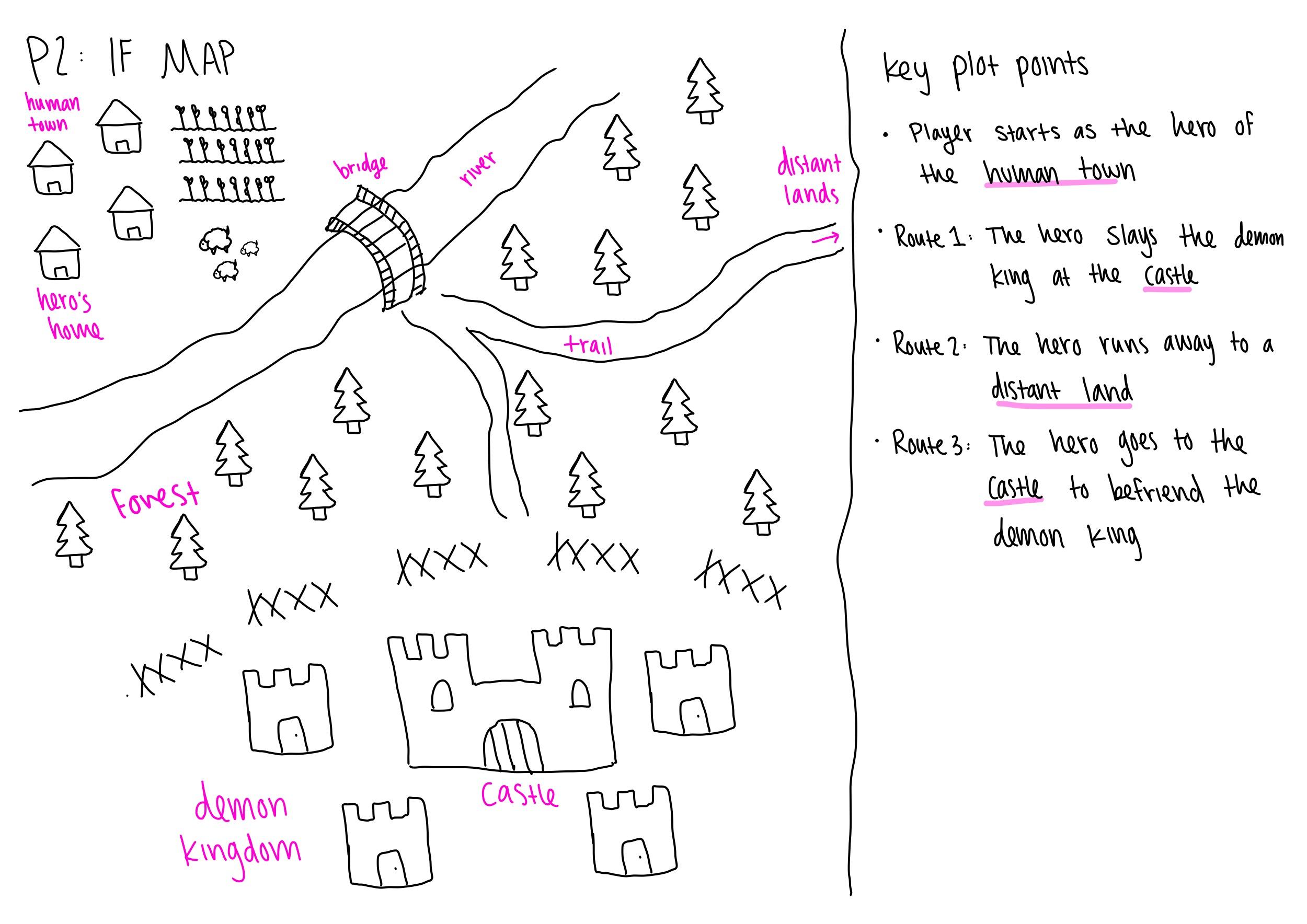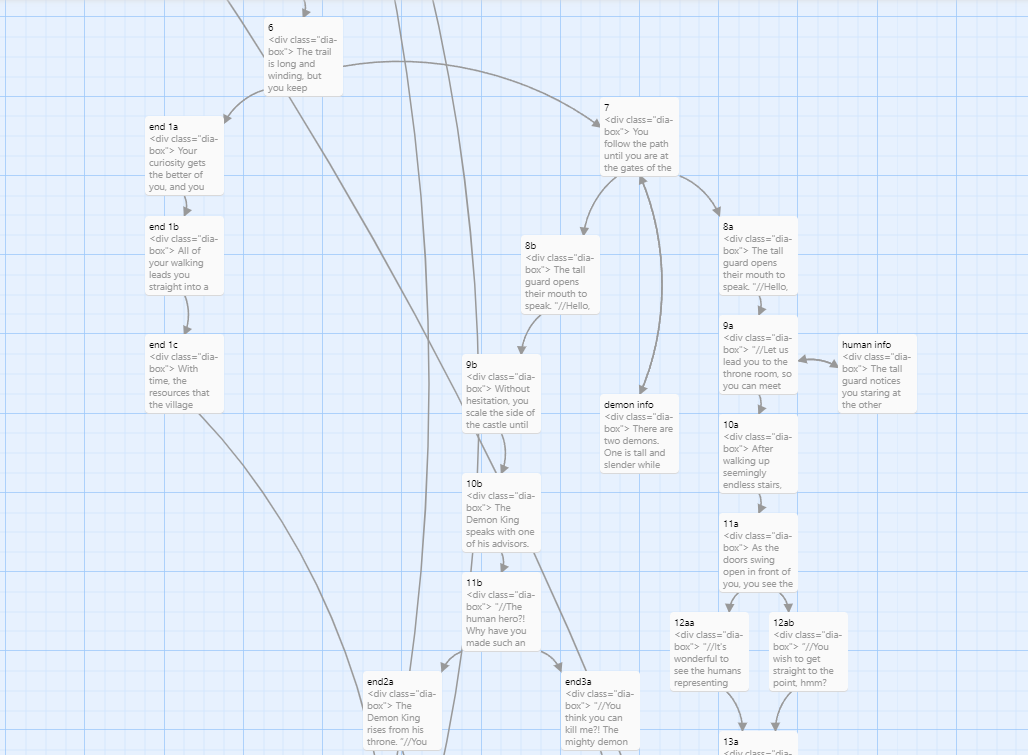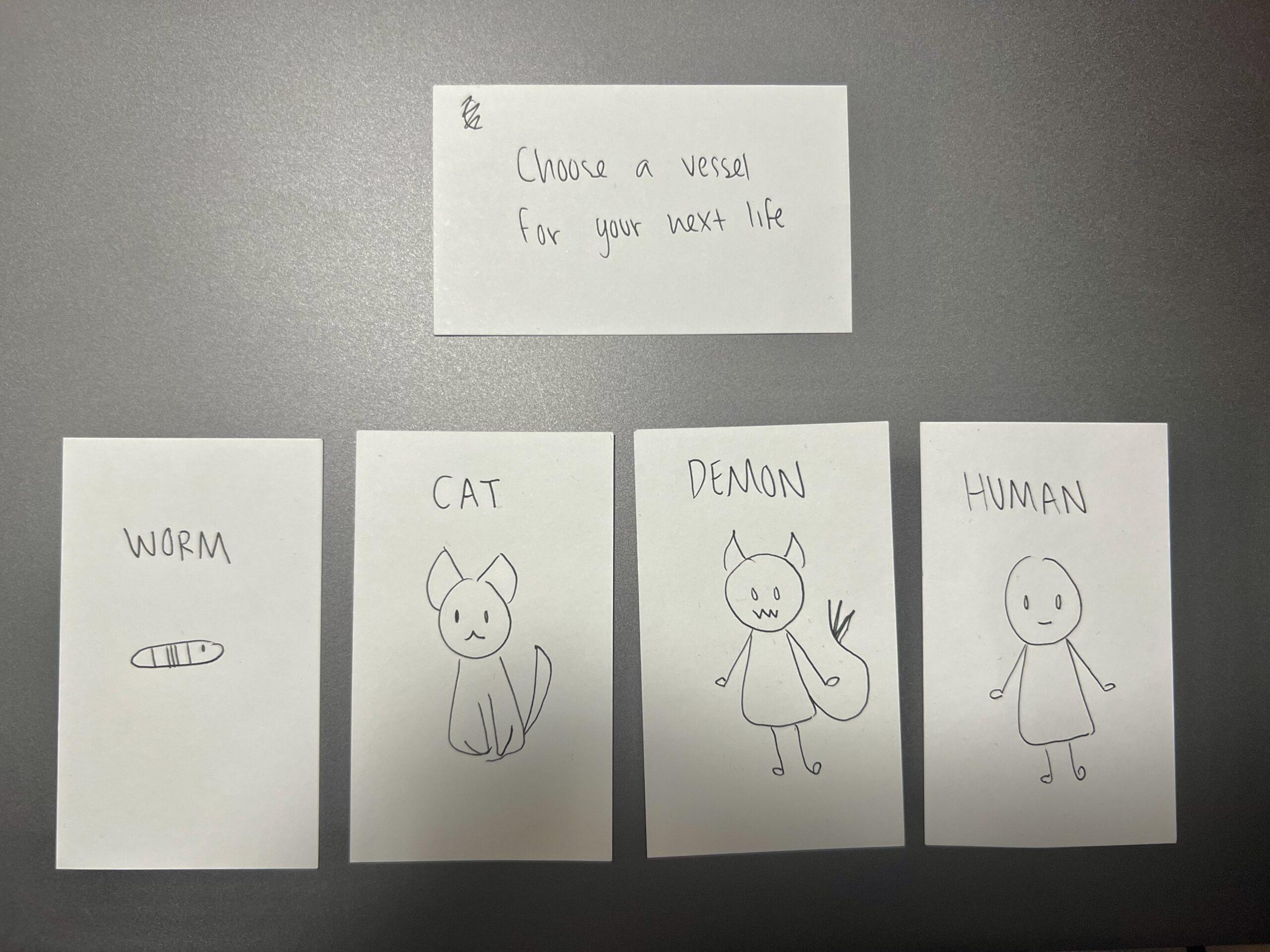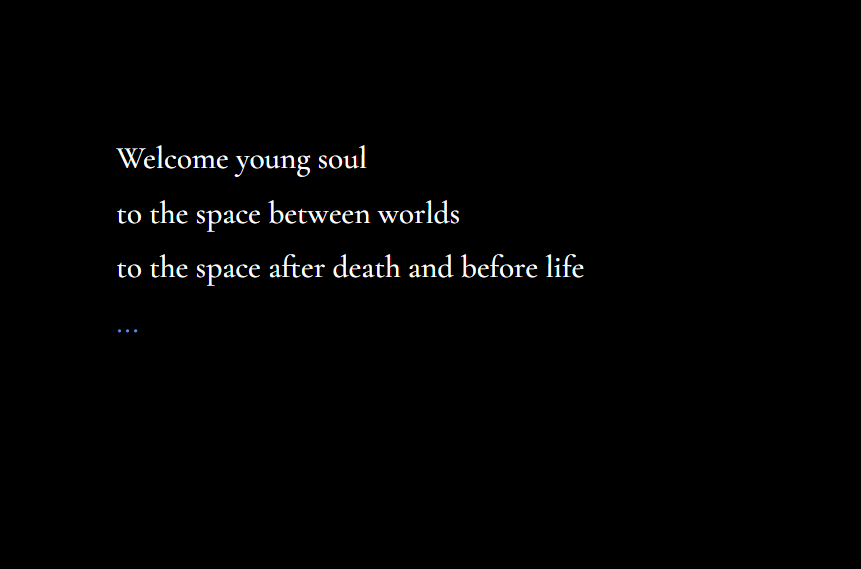[Note: please play the game before reading about the process]
Link: https://codewordpickle.itch.io/afatedfable
Overview & Premise:
A Fated Fable takes us into a dystopian parallel universe where souls cycle through life and death. Everything they experience throughout their lives is already decided for them by fate. If a soul tries to make their own decisions, the god of fate will punish them with a variety of cruel deaths.
In the game, the player becomes an ambiguous soul in the void between life and death. They are spoken to by a seemingly unknown deity who gives them the task of “rejecting” their fate such that they can reclaim freewill for themself and all of the other souls. With this objective, the soul is put into a human that lives in a world where demons and humans are at war. This particular human is the “chosen” hero of their village. They are told that their destiny is to kill the Demon King and end the ongoing war.
The player loops through this hero lifetime multiple times (living, dying, and starting over) with their choices affecting how they grapple with the role fate has given them. There are a handful of different endings for the player to explore. They might choose to run away to a distant land and reject their responsibility as the village hero, or they might choose to befriend the Demon King and find a peaceful resolution to the war. These are just two examples.
The catch is that no matter what route the player takes to try to deny their fate they will always meet a cruel death and seemingly fail. Only after completing the longest possible route to death will the player return to the void. At this point, it will be revealed that the original deity was actually the god of fate who asked the player to complete an impossible task for its own amusement. At this point, the player will have the choice to give up and submit to fate or fight back. If the player chooses to fight fate, they will succeed in killing the god of fate and get to choose a happy ending of their choice: returning to a peaceful Demon Kingdom or living a new life.

Meaningful Choices:
When approaching this assignment, we were told to think about how to give the player meaningful decisions. As a fan of games that subvert the player’s expectations, I wanted to see if I could make an interactive fiction game that intentionally gave the player “meaningless” decisions that were still rewarding to explore. I think A Fated Fable was successful on this front because while the player knows that all of their choices end in death, they are still motivated to make them because their choices are essential to discovering the various ways things can go terribly wrong for the hero.
Learning Goals:
I wanted to analogize the player’s lack of control to something they might feel in the real world as a way of adding real-world values to an otherwise fantasy game. I decided the concept of fate would be a good direction as in our everyday lives, we often question whether we are making decisions for ourselves, out of our own freewill, or because someone else told us to. This is the kind of reflection I want players to be thinking about as they explore the routes. Are they really in control of the direction of their life?
There are also more nuanced themes in some of the different endings. For example, as the hero seeks peaceful resolution with the demons, they are reminded of how they must make the individual choice to defy the prejudice against demons that has been passed down for generations of humans. Therefore, players can also reflect on their role in larger societal trends and consider whether these trends are things they want to break.
The Medium:
I made my IF game with Twine (sugarcube). Learning how to use the platform for the first time was certainly a challenge. Nevertheless, I tried to make use of the medium in as interesting a way as I could. Notably, my game includes name input, character customization choices, some transitional effects, and a bit of custom styling in the fronts and borders. If I had more time, I would have liked to add some dynamic text effects (trembling text specifically), images, and sound effects.


History:
Playtest 1 – 02/02/2023
I playtested A Fated Fable for the first time with two of my peers in class. At this point, I was using a paper prototype to get an idea of whether or not the game’s introduction had the emotional impact that I hoped it would. The paper prototype consisted of cards that players would shuffle through and flip to mimic the delayed/slow appearance of dialogue. The players had to go through a player creation phase where they wrote their player name on a card and selected a drawing of a physical form from four pre-made options.

Some of the key observations from the first playtest are as follows:
- Players enjoyed the anticipation of flipping the cards to reveal the next line of dialogue.
- Players liked the stylized language used for the dialogue and began reading the text aloud in a grandiose voice.
- Players spent a significant amount of time trying to decide what name and form would be the best choice. They considered pros and cons for each.
- Players were shocked when their creation was destroyed. There was an “oh noooo” moment.
- Players were excited by the premise but thought they would need to see more of the story to see if it followed through with its potential
- Players wanted even more ways to customize their character even after knowing that it would later be destroyed.
From this playtest, I realized that some aspects of the storytelling should be embedded in the game’s visual/experience design rather than directly stated. Players were more immersed when there was aesthetic consistency between the language of the dialogue, the way it was presented, and how it moves the story along. I incorporated this feedback into my next Twine prototype by adding a slow fade-in effect to the introduction text, continuing the old-timey language, and adding a formal looking font. Another takeaway was making sure to pay attention to how I respect the user’s time in my effort to subvert their expectations. I want players to be invested in their character creations, but I don’t want them to spend so much time creating their character that they are annoyed when their efforts are thrown away. Responding to the feedback, I decided to limit the more complex decisions (form) to only two options and build a connection through decisions that feel more personal and less influential like hair color or personality traits.
Playtest 2 – 02/14/2023
The second playtest was with another peer from class who had not previously played my game. At this point, I moved my prototype onto Twine, but there was only one playable route fully completed. This route was the one in which the player tries to run away but dies in the desert. It is worth noting that the introduction portion of the game was not fully automated. I had to control some aspects of the character customization phase as it hadn’t been fully implemented yet. I thought this was fine because my priority for this playtest was to see how the player interacted with the die and try again mechanic of my game.

Some of the key observations from the second playtest are as follows:
- The player thought the vision was very clear in the introduction.
- They enjoyed the flash effect as the player shifts from the void to the mortal world.
- They thought it was fun but could potentially get annoying if the game looped for 40+ minutes before reaching an end.
- They were curious about how the fantasy setting and characters translated to the learning goals. They imagined the rigid social structures of kingdoms aligned with aesthetic of lacking control.
- They wanted a true ending where fate can be defeated.
I took note that the player enjoyed having the void and mortal world feel distinct in the game. To build further on this strong point, I decided to add a border around all of the text in the mortal realm. I hoped that this would make it visually different from text in the void and add to the feeling of “distance” between those spaces. I also took into consideration the word of caution about the game not being longer than 40+ minutes of looping. As I finished implementing the routes, I aimed for simplicity. I tried to make the text and decision trees concise. I wanted the game to have a “die fast, win fast” dynamic such that it can be completed within ~20 minutes, before the player gets tired or annoyed. Lastly, the true ending of the game includes a way to defeat fate. This was brought up in the playtest because the true ending had not yet been implemented.
Playtest 2 – 02/16/2023
The third playtest was with one of my friends who had no prior experience with interactive fiction games. All of the core parts of my game were fully implemented in Twine. I did not give the playtester any instructions or interfere while he was playing. My goals for this playtest were to see how the game felt holistically and what the player took away from the experience.
Some of the key observations from the third playtest are as follows:
- The player got stuck on the first screen because they didn’t realize they had to click on the blue “…” at the bottom of the dialogue to progress. They tried clicking around randomly and hitting enter.
- There was a small typo in one of the decision texts that distracted the player for a few seconds.
- They enjoyed the different endings! Even after getting the true ending of the game, they played it two more times just to explore all of the possible routes.
- They wanted more routes that were separate and unique. They didn’t like getting the same ending through different paths.
- They thought the character customization was fun. They
didn’t spend more than a few seconds thinking about their choices, but they replayed the game just to see their choices come back in the “live a new life” true ending. - They said that they “respected the theme”, but it was also a bit depressing to think about.

The easiest fix from this playtest was switching the “…” in the introduction to “>>” as I thought this would more obviously convey a way of progressing to the next page. If I had more time and a better understanding of Twine, I would have liked to make the enter key another way of going to the next page. I also fixed the distracting typo in the decision choice! The other feedback would have been harder to implement given how close the project deadline was. However, it helps identify further areas of work. If I were to continue working on this game, I would remove the multiple routes that lead to the same ending and make these routes fully unique. This would make the looping exploration more rewarding and less costly to the player. Additionally, I would think about how to narratively add more small joys along the routes even if they still inevitably end in despair.
Reflection
With this project, I set out to build a game that undermines the player’s decisions without removing the value of choosing. I wanted to inspire reflection in the user by having them persevere through seemingly hopeless scenarios while inching towards reclaiming control of their life. I wanted players to think about how people or structures in their own lives may try to force them into playing a certain role. Despite these forces in their life, they can always keep trying to make the decisions that they want.
I learned about how a game’s aesthetics emerge from not only the narrative/text itself but also from the ways in which the narrative is conveyed to the player. I learned to pay more attention to the small details (font, transitions, wording) and how these details come together to convey a lot of information to the player. With future games, I will try to balance my attention more evenly between the high-level aesthetics and the small details that make those aesthetics possible/impactful.



I really, really enjoyed Miranda’s game! I was able to immediately understand, after choosing my “character,” that in this dystopia, my choices didn’t matter – I was in a world where I no longer had free will. I had the opportunity, though, to test fate and see whether I could get it back. I was very curious as to how my character choices would serve me, and whether I would be successful. The value of the game – questioning the root of decisions, control / free will, etc. was very powerful and revealed through an interesting dynamic / discovery process because though I made choices throughout the game, and those choices led down different paths, after replaying the game multiple times, I was never successful in testing fate (I would always fail)! This tension between being able to choose different characters, and make choices, but ultimately have the same ending (death), really makes you think about if choices, in the game and real life, really do matter.
I thought Miranda’s learning goals were very effective. As mentioned above, crafting the different, seemingly meaningful choices, that all ultimately showed you can’t avoid fate, really led to a lot of reflection about decision-making and thinking about what control we have over certain directions of our lives.
Miranda’s game was very engaging, as Miranda definitely took advantage of using Twine’s platform – allowing for player input, different fonts / graphics, and especially the picking a vessel for your next life (being able to iterate through options to choose your “character” and have that show later in the story). I liked how Miranda disabled the option for the “back” button, so you are forced to re-run through the game if you were curious about another character or choice, too.
Miranda’s premise, implementation, and iterations were very well documented.
Miranda’s choices were meaningful and engaging (I was curious to run the game multiple times to see if I could tempt fate as a demon, vs human, and if fate cared whether I advocated for peace or not).
Reiterating a few of the awesome things I said above, I really loved Miranda’s choose your own character interaction, and the branching of all possible paths in the story. Moving forward, I think it might be cool to play around with the graphics a little bit more – any colors? Or background images or animations that might help convey the story better?
I really enjoyed this game! I was one of the first playtesters, so I had a sense of where it was going, but I was very impressed with the final product. This game plays with values of self-actualization and touches on leadership. By putting the player in an endless life-death cycle until they confront the God of Fate Itself, the game forces the player to think about their own real-life path and choices.
The game definitely got me to think. I was very invested in trying to dupe fate, but somehow was always brought back. Miranda’s use of medium was awesome, and pushed the boundaries of what I thought Twine could do; the use of font, text fading and speed, word choice within possible choices brought this text-based game to another level. With the addition of screen fade transitions and the creation of a border around everything happening in the mortal world, Miranda really captured the feeling of two different worlds that I was going back and forth between. Excellent use of medium!
The game itself was all about choices and so its choices were inherently interesting. I think in playing branching text-based games like this one, I always have the tendency to explore the alternate endings and it’s hard for me to ignore the other possible branches. In this game, that feeling is capitalized upon as it becomes imperative for the player to explore the other branches to even reach the ending! Thus, I was thinking about my choices every step of the way.
In terms of room for improvement, I think the introduction could be built up a bit more. In the original playtest I did, Miranda tore the paper identity I had chosen right before my eyes. This was painful to watch. I would like it if the game could somehow capture that rrrrrrip of the page that I myself experienced. Additionally, I think forcing the player to have multiple screens of character customization (rather than having it all on one screen) would draw out this interaction, heighten the buildup, and make the twist that much better. Also, I would LOVE to see this made in RPGMaker or something like that. I know it’d be a ton of work, but I think it’d go really well as an Undertale-type thing (which should be understood as very high praise).
Great work, Miranda!